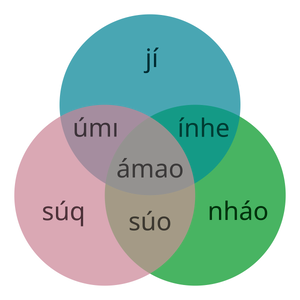Pronoun: Difference between revisions
(HOLY CRAP THAT IMAGE WAS HUGEEEEEE) |
No edit summary |
||
| Line 1: | Line 1: | ||
Toaq has relatively many '''pronouns'''. It makes distinctions that English does not: | |||
== | [[Image:jı, suq, nhao.png|A Venn diagram of personal pronouns.|thumb|300x300px|right]] | ||
* '''Clusivity''': there are many words for “we” depending on who exactly is included. | |||
* '''Exophora vs. anaphora''': there are different pronouns for “things or people external to the text” ([https://en.wikipedia.org/wiki/Exophora exophora]) and for “references to earlier phrases” ([https://en.wikipedia.org/wiki/Anaphora_(linguistics) anaphora]). | |||
* '''[[Animacy]]''': there different pronouns for “he/she/it” for animals, objects, and ideas. There are even different anaphoric pronouns for different types of grammatical constructs. | |||
<div style=display:inline-table> | |||
{| class="wikitable" | |||
|+ Exophoric pronouns in Toaq | |||
|+ align="bottom" style="caption-side: bottom; font-weight: normal" | *Unofficial but popular | |||
|- | |||
! Pronoun !! Meaning | |||
|- | |||
| {{t|jí}} || I, me | |||
|- | |||
| {{t|súq}} || you | |||
|- | |||
| {{t|nháo}} || he, she, they | |||
|- | |||
| {{t|súo}} || y'all (you and they) | |||
|- | |||
| {{t|múy}} || we (you and I) | |||
|- | |||
| {{t|míy}} || we (they and I) | |||
|- | |||
| {{t|máy}} || we (you, they, and I) | |||
|- | |||
| {{t|kóu}}* || it (inanimate object) | |||
|- | |||
| {{t|ráy}}* || it (abstract) | |||
|} | |||
</div> | |||
<div style=display:inline-table> | |||
{| class="wikitable" | |||
|+ Anaphoric pronouns in Toaq | |||
|- | |||
! Pronoun !! Meaning | |||
|- | |||
| {{t|hó}} || he/she/they (latest [[Animacy|class I animate]] determiner phrase) | |||
|- | |||
| {{t|máq}} || it (latest [[Animacy|class II inanimate]] DP) | |||
|- | |||
| {{t|hóq}} || it (latest [[Animacy|class III abstract]] DP) | |||
|- | |||
| {{t|tá}} || it (latest [[Animacy|class IV adjective-like]] DP) | |||
|- | |||
| {{t|róu}} || it (latest {{Tone|5}} [[content clause]]) | |||
|- | |||
| {{t|kúy}} || it (latest {{t|lu}} DP) | |||
|- | |||
| {{t|zé}} || it (latest [[object incorporating verb]] DP) | |||
|- | |||
| {{t|fúy}} || he/shey/they/it (latest non-{{t|fuy}} pronoun) | |||
|- | |||
| {{t|bóu}} || it (latest [[demonstrative]] noun phrase) | |||
|- | |||
| {{t|áq}} || itself/himself/herself/themselves (clause subject) | |||
|- | |||
| {{t|chéq}} || each other (reciprocal with clause subject) | |||
|} | |||
</div> | |||
== Notes == | |||
* All living animals have the pronoun {{t|nháo}} in Toaq, not just humans. | |||
* The subject (first argument) of a clause only binds the anaphoric pronoun {{t|áq}}, so you cannot use {{t|hó, máq, hóq…}} to refer to it. | |||
* For each pronoun, there's a verb crated by affixing {{t|-bo}} to it that means “___ is (that pronoun)'s”. | |||
** For example, {{t|suqbo}} means “yours” and {{t|tabo}} means “its” (belonging to the referent of {{t|tá}}). | |||
Revision as of 12:45, 5 July 2022
Toaq has relatively many pronouns. It makes distinctions that English does not:
- Clusivity: there are many words for “we” depending on who exactly is included.
- Exophora vs. anaphora: there are different pronouns for “things or people external to the text” (exophora) and for “references to earlier phrases” (anaphora).
- Animacy: there different pronouns for “he/she/it” for animals, objects, and ideas. There are even different anaphoric pronouns for different types of grammatical constructs.
| Pronoun | Meaning |
|---|---|
| jí | I, me |
| súq | you |
| nháo | he, she, they |
| súo | y'all (you and they) |
| múy | we (you and I) |
| míy | we (they and I) |
| máy | we (you, they, and I) |
| kóu* | it (inanimate object) |
| ráy* | it (abstract) |
| Pronoun | Meaning |
|---|---|
| hó | he/she/they (latest class I animate determiner phrase) |
| máq | it (latest class II inanimate DP) |
| hóq | it (latest class III abstract DP) |
| tá | it (latest class IV adjective-like DP) |
| róu | it (latest |
| kúy | it (latest lu DP) |
| zé | it (latest object incorporating verb DP) |
| fúy | he/shey/they/it (latest non-fuy pronoun) |
| bóu | it (latest demonstrative noun phrase) |
| áq | itself/himself/herself/themselves (clause subject) |
| chéq | each other (reciprocal with clause subject) |
Notes
- All living animals have the pronoun nháo in Toaq, not just humans.
- The subject (first argument) of a clause only binds the anaphoric pronoun áq, so you cannot use hó, máq, hóq… to refer to it.
- For each pronoun, there's a verb crated by affixing -bo to it that means “___ is (that pronoun)'s”.
- For example, suqbo means “yours” and tabo means “its” (belonging to the referent of tá).
